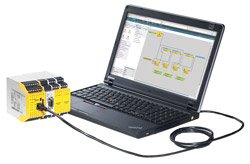
Posted to News on 28th Jan 2019, 14:01
How enhanced motion safety functionality improves machine safety
Warren Gourlay, UK and Ireland sales manager for industry and automation solutions at Wieland Electric, looks at reducing risks for machine operators by means of enhanced motion safety functionality.

Due to the high automation of production lines and systems, the level of interaction between the machine and user has increased. Therefore enhanced motion safety functionality has to be considered when designing and developing machine motion systems. Key areas to consider would be:
Avoidance of unwanted movement / safe shutdown (EN 61800-5-2):
- Avoidance of unwanted movement through safe power disconnection (safe pulse disabling)
- Functions for safe (monitored) shutdown
Safe movement:
- Limited movement under certain conditions
- Monitoring of speed, direction, step width and position
- With reference to the individual axis
Safe co-ordinated movement:
- Limited movement of several drives under certain conditions
- Monitoring of speed, direction, step width and position
- With reference to the tool centre point (safe co-ordinate transformation)
There is no general definition for torque or speed limit values that can be considered safe enough to prevent operators from being put at risk. Depending on the machine, different speeds are considered to be safe. The IFA manual for safety and health protection at the workplace, classification number 330216 [11], contains an overview of appropriate definitions in machine-specific standards (C-type standards). To give more flexibility to automation safety control, automation safety controllers provide ways to meet these increased motion monitoring demands.
Motion functions covered in the standard EN 61800-5-2 such as SLS (Safe Limit Speed), Standstill Monitoring, SSR (Safe Speed Range), SDI (Safe Direction), SSM (Safe Speed Monitoring) and SLP (Safe Limit Position) are now commonplace requirements among machine builders when developing motion systems.
Error-free implementation

The Standard six-pack motion function blocks (SLS, SSR, SDI SSM, SLP and Standstill Monitoring) enable fast acceptance through accreditation bodies such as TUV, UL and DGUV, enabling cost-effective and rapid implementation to reduce development time significantly.
Understanding the standards that apply to various machine designs and applications is crucial. A recent Control Design magazine survey found that the top safety-design headache for machine builders was determining which standards and regulations apply. Similarly, nearly two-thirds of manufacturers said 'compliance with regulatory and safety standards' is the biggest driver behind their improved safety practices. In some instances, a worker may need to service, inspect or interact with machinery, and safety functions such as Safe Standstill Monitoring can ensure safety while this happens. Other functions such as Safe Speed Monitoring (SSM) will keep the machinery moving at a designated safe speed when workers enter production areas for calibration and setup.
The approach has advantages for different industries; for example, the printing industry where safe speed can help an operator more quickly and safely clean the rolls on a printing press by reducing the speed and even the direction of the rolls. This helps shorten the duration of the cleaning process because the rolls can be cleaned continuously while they turn. It also can improve safety because the rolls are operating at a decreased speed and are now turning outward, away from the machine, instead of inward.
Safe-speed monitoring
Likewise, in the food industry, in the event of a production issue, safe-speed monitoring can enable an operator or maintenance technician to open a safety door and make adjustments, such as correcting a dispensing nozzle, while production continues at a reduced rate. This enables the operator or technician to monitor the adjustments as they are made, thereby eliminating the need to continually shut down and restart the machinery for each adjustment until the issue is resolved.
Both of these examples are where the introduction of the safety systems is initiated at the design stage, not only improving the efficiency of the process but maintaining the current safety standards.
In addition to the cost savings at the design stage, using programmable safety controllers with enhanced motion and diagnostic capability allows for much faster fault-finding during commissioning, as well as reduced setup time and improved machine throughput during normal running. Further enhancements can be made within the system with the introduction of remote access via cloud technology and secure VPN routers. This enables quick and easy access from anywhere in the world for diagnosing faults and getting the production back up and running without the need to physically travel to the machine site, which saves much wasted time and expense.
So, to summarise, the modern machine builder is embracing new safety legislation and standards, using them as tools and guidelines to produce safer, more efficient machines with benefits for both OEM machine builders and end users alike.
Learn more at www.wielandsafety.net.
Ash House, Tanshire Park
Shackleford Road
GU8 6LB
UNITED KINGDOM
+44 (0)1483 531213






























